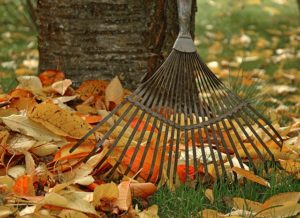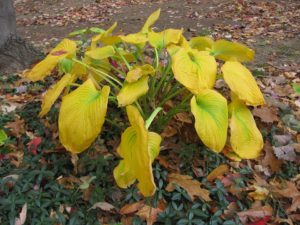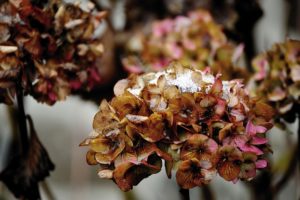Putting Your Garden to Bed for the Winter in Edmonds
By Maxine Mitchell.
As the days grow shorter and chillier, homeowners need to conduct the age-old practice of “putting the garden to bed” for the winter. “What is that?” you might ask. Well, it’s a lot of things, but essentially, it’s doing a final pruning and clean-up and making sure your plants are protected for the winter ahead.
 Fallen Leaves
Fallen Leaves
Fallen leaves may or may not be raked up as there are several schools of thought on this subject. If you leave them, they serve as a mulch and insulator for your plants, protecting your perennials from winter’s damage. However, they provide a perfect breeding ground for slugs and burrowing insects. So, it’s up to you. It might be unsightly but laying dried leaves close to the base of your perennials isn’t a bad idea, allowing moisture to get to the plants while providing a layer of protection. The alternative is to lay compost around the base of the plants, but not too close to the main stem or trunk of the plant.
Perennials
Many perennials may be cut back to the ground now as we’re approaching our first frost when they start to look ratty or mushy. But, early spring is the ideal time to cut back perennials, if you’re not too finicky about appearances. Waiting ensures that the plant will survive the winter as you’d be waiting until you see new growth before pruning or cutting back. Ideally, plants need to slow  down and go into dormancy before pruning. Plants that can be cut back successfully now include peonies as you’d inhibit foliage diseases from forming over the winter. Placing cut fern fronds over the peonies will protect the tender “eyes” over the winter months. Other perennials that may be cut back are dahlias, daylilies, and hostas. A product called Remay or any porous fabric (not plastic) may be laid over the plants or wrapped around the base of the plants for protection from the cold.
down and go into dormancy before pruning. Plants that can be cut back successfully now include peonies as you’d inhibit foliage diseases from forming over the winter. Placing cut fern fronds over the peonies will protect the tender “eyes” over the winter months. Other perennials that may be cut back are dahlias, daylilies, and hostas. A product called Remay or any porous fabric (not plastic) may be laid over the plants or wrapped around the base of the plants for protection from the cold.
Cut back any perennials that exhibit disease or insect damage now. Examples of this are plants with powdery mildew or excessive slug damage. But, be sure to put the foliage in the trash and not toss it in the compost bin to reduce the chance of spreading it.
An argument for leaving your perennials in place is that it may provide food for wildlife and birds, not to mention offering winter interest in the landscape. An example of this is Echinacea purpurea (coneflower), Rudbeckia (black-eyed Susan), and ornamental grasses, which provide dried seedheads for birds. Dried grasses are lovely as their stems sway in the breeze. Any plants that produce seed heads, berries, or nuts provide needed food for our winter feathered friends and beneficial insects. In the Spring, all of these plants may be cut back to the ground to encourage new growth.
 Roses
Roses
Wait to do your major pruning of roses until after President’s Day. If you have very tall floribundas or tea roses, they may be cut back to a manageable size to prevent them from toppling over by the harsh winter’s winds.
Hydrangeas
Hydrangeas are always a source of puzzlement among homeowners. Whether to prune now or wait? How far back? Gardeners who have pruned too much have experienced no flowers in the  spring because they pruned off all the flowering buds. It’s important to know what type of hydrangea you have as they have different pruning strategies. With mopheads, waiting until you see new buds in the spring is most prudent. Then, selectively cutting one-third of the older stems to the ground and pruning back to just above the 2nd bud from the tip will ensure future flowers and a more open, airy plant. Some of the newer varieties of hydrangea may be cut all the way to the ground in the fall or spring. The worst that can happen if you cut too much is sacrifice one year’s worth of blooms, but it shouldn’t kill the plant.
spring because they pruned off all the flowering buds. It’s important to know what type of hydrangea you have as they have different pruning strategies. With mopheads, waiting until you see new buds in the spring is most prudent. Then, selectively cutting one-third of the older stems to the ground and pruning back to just above the 2nd bud from the tip will ensure future flowers and a more open, airy plant. Some of the newer varieties of hydrangea may be cut all the way to the ground in the fall or spring. The worst that can happen if you cut too much is sacrifice one year’s worth of blooms, but it shouldn’t kill the plant.
Evergreens
Evergreens or plants that stay green all year may or may not be pruned now. Remember that pruning stimulates growth if done too early so waiting until the plant is dormant is safest. Ideally, you might want to wait until early spring or when you see new growth forming to do much pruning of your evergreen trees or bushes. Otherwise, you risk winter injury to the freshly cut stems.
Vegetable Gardens
Vegetable gardens should be cleaned up with all debris removed and sent to the compost heap or trash (if diseased) as part of putting your garden to bed for the winter. The latest trend is not to till the ground at all, but lay a few inches of compost over the bed after raking it smooth. That way, all the beneficial insects and microbes can do their job over the winter without disturbance. Laying porous fabric or burlap bags over the beds will provide a layer of protection and insulation while also inhibiting weeds from forming. Other gardeners plant a cover crop that grows over the winter and is tilled into the soil in the spring, providing a rich source of nitrogen to the soil.
Whichever method you choose to put your garden to bed before winter comes will involve some amount of work. But, the sooner you get to it, the better and you’ll be glad you did it. Then, you can sit back in your warm abode with your cup of steaming coffee or hot chocolate and dream about spring when it starts all over again.

